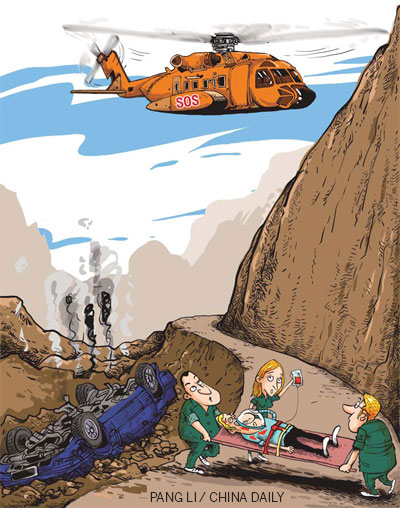Society
More adventurers hurt, push limits
By Jiang Xueqing (China Daily)
Updated: 2011-06-05 07:38
 |
Large Medium Small |
With an increasing number of people seeking thrills in the great outdoors, injuries and even deaths are climbing. Jiang Xueqing looks at how teams step up to help.

While climbing the Tiger Leaping Gorge in Lijiang, Yunnan province, on Jan 21, a 26-year-old United States man tumbled and broke his neck and skull.
He was rushed to the Lijiang People's Hospital, but it was too small to perform the difficult surgery he needed and his friend called the Beijing alarm center for International SOS for help.
Within 48 hours, the medical assistance provider had arranged an air ambulance and sent a medical team to Lijiang to evacuate the injured climber and take him to the Hong Kong Baptist Hospital for an operation and follow-up treatment.
The surgery was successful, and he left hospital on Feb 9 and returned to the US.
With more and more people enjoying mountaineering and outdoor activities in China, such accidents have risen significantly since 2007, said Peng Chunhong, a founder of the Lvye Rescue Team in Beijing.
Formed by more than 500 volunteers who love mountaineering, Peng's team receives phone calls from people needing help every week.
According to the latest report released by the Chinese Mountaineering Association, 33 people died in mountaineering accidents and while participating in outdoor sports in China in 2010. The tally equals the total death toll from such accidents in the period between 1957 and 2000.
Causes of the recent spate of deaths include altitude sickness, avalanches, falls, getting lost, drowning and traffic accidents.
"The accidents have increased in recent years as people taking part in outdoor sports have grown in number," said Yan Weicheng, marketing director of Sanfo Tigo Sports Management, whose company has document the changes since 2007.
"A considerable number of accidents take place in relatively dangerous places, such as on high-altitude snowy mountains, which shows that travelers are pursuing challenges at a higher level."
In May 2009, US climbers Jonathan Copp, 35, Micah Dash, 32 and their filmmaker Wade Johnson, 24, disappeared while attempting a new route up the southeast face of the 6,618-meter Mount Edgar within the Gongga Shan massif in Sichuan province.
A Chinese search and rescue team found the bodies of Copp and Johnson among avalanche debris, along with some of Dash's gear. The rescuers, later joined by a US rescue team from Colorado, said they believe the climbers were likely caught in an avalanche near their advanced base camp. They had to give up searching due to bad weather and the danger of additional avalanches. Dash's body is still missing.
"In spite of the growth of participants in outdoor sports, the public still lacks education about outdoor safety," said Ci Luo, deputy director of the mountaineering team of the Chinese Mountaineering Association.
"Some people like to try a new route and avoid the usual one and lose their way during such advances. Some prefer traveling alone and nobody knows where they went or which routes they took. Once they get lost or injured, it is hard for them to receive help promptly. Others lack the necessary outdoor gear, which is reported to be one of the major causes for accidents."
His association received nearly 2 million yuan ($309,000) from the central government this year to buy search and rescue equipment and organize training for major rescue teams, outdoor sports clubs and mountain area staff across the country. Some non-government rescue teams, like Lvye, also held seminars at universities in Beijing to teach students what kind of dangers they are likely to encounter during outdoor sports activities and how to help themselves and each other when they become injured. However, large-scale training that reaches beyond the campus, rescue teams and sports clubs is unavailable.
| 分享按钮 |